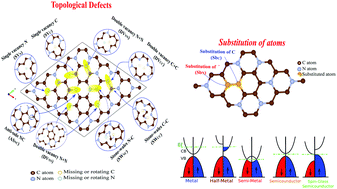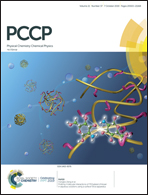Introducing novel electronic and magnetic properties in C3N nanosheets by defect engineering and atom substitution†
Abstract
Using first-principles calculations the effect of topological defects, vacancies, Stone–Wales and anti-site and substitution of atoms, on the structure and electronic properties of monolayer C3N are investigated. Vacancy defects introduce localized states near the Fermi level and a local magnetic moment. While pristine C3N is an indirect semiconductor with a 0.4 eV band gap, with substitution of O, S and Si atoms for C, it remains a semiconductor with a band gap in the range 0.25–0.75 eV, while it turns into a metal with H, Cl, B, P, Li, Na, K, Be and Mg substitution. With F substitution, it becomes a dilute-magnetic semiconductor, while with Ca substitution it is a ferromagnetic-metal. When replacing the N host atom, C3N turns into: a metal (H, O, S, C, Si, P, Li and Be), ferromagnetic-metal (Mg), half-metal (Ca) and spin-glass semiconductor (Na and K). Moreover, the effects of charging and strain on the electronic properties of Na atom substitution in C3N are investigated. We found that the magnetic moment decreases or increases depending on the type and size of strain (tensile or compression). Our study shows how the band gap and magnetism in monolayer C3N can be tuned by introducing defects and atom substitution. The so engineered C3N can be a good candidate for future low dimensional devices.



 Please wait while we load your content...
Please wait while we load your content...